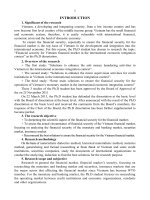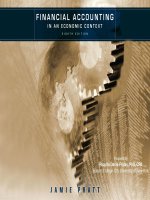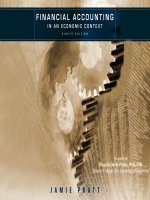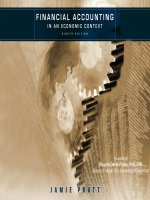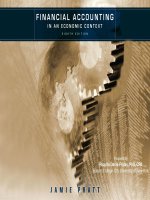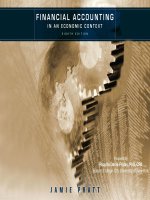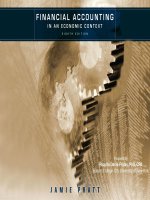Financial accounting in an economic context 8e chapter 09
Bạn đang xem bản rút gọn của tài liệu. Xem và tải ngay bản đầy đủ của tài liệu tại đây (644.25 KB, 32 trang )
1
Chapter 9:
Long-Lived Assets and Cost
Allocation
2
Capitalize vs Expense
Revenue Expenditures
– Merely maintain a given level of services
– Should be Expensed
Debit Expense
Capital Expenditures
– Provide future benefits (useful life > 1 year)
– Should be Capitalized
Debit Asset
3
Overview of Accounting for
Property, Plant, and
Equipment
4
1. Acquisition - What Costs to
Capitalize?
General
Rule:
– Capitalize (add to an asset account)
the costs to acquire the asset and to
prepare it for its intended use.
Dr. Asset (purchase price, sales tax,
delivery, installation, etc)
Cr. Cash, Notes Payable, etc
5
Land
– Has indefinite life and therefore is not depreciated
– Historical Cost includes:
Purchase price, Closing costs, Cost to get ready for intended
use (Note: Sale of salvaged materials reduces cost)
Land Improvements
– Have definite life and therefore are depreciated
– Fences, walls, parking lots, driveways
Buildings
– Have definite life and therefore are depreciated
– Proportionate share of purchase price, or construction
cost, Closing Cost, Architect & Attorney fees
Machinery, Equipment, Furniture & Fixtures
– Purchase price (net of cash discounts), Freight &
handling, Insurance while in transit, Installation
Self Constructed
Assets
What to Capitalize?
Direct
Materials & Labor
Variable Overhead
Apply Fixed Overhead
Interest During Construction, if constructed
–for
company’s own use
–by someone else and progress payments &/or
deposit are required
2. Depreciation
(Cost Allocation)
Depreciation is a method of cost allocation.
– it is used to allocate the capitalized
cost of PP&E over the years benefited
(matching)
– Note: depreciation will decrease the
carrying value of the asset, but it is
not a valuation technique (i.e., book
value is not market value)
8
2. Depreciation
(Cost Allocation)
Useful Life
Salvage Value
Depreciation methods
– (1) Activity (units-of-production)
– (2) Straight-line
– (3) Double-declining balance
– (4) 150 percent declining balance
– (5) Sum-of-the-years digits
– (6) MACRS (income tax depreciation)
– Under IFRS, depreciation accounting is very
similar to US GAAP.
9
Class Example
Given the following information regarding an automobile purchased
by the company on January 2, 2008:
Cost to acquire = $10,000
Estimated life = 4 years
Estimated miles = 100,000 miles
Salvage value = $2,000
Calculate depreciation expense for the first two years under each of
the following methods.
10
(1) Units-of-Production (Activity)
Assume that the car was driven 20,000 miles in
the year 2008, and 30,000 miles in 2009.
Annual depreciation =
Cost - Salvage Value
x Current Activity
Total expected activity
For 2008= 10,000 - 2,000 x 20,000 = $1,600
100,000 miles
For 2009 = 10,000 - 2,000 x 30,000 = $2,400
100,000 miles
11
(2) Straight-Line
Annual depreciation =
=
Cost - Salvage
Estimated Life
$10,000 - $2,000 = $2,000 per year
4 years
12
(3) Double-Declining Balance
DDB is an accelerated depreciation technique. It
generates more expense in the early years and
less in the later years.
Annual depreciation = % (Cost - A/D)
where A/D is the accumulated depreciation for
all prior years, and the percentage is double
the straight line rate, or 2 x 1/Estimate life. In
the example, the % = 2 x 1/4 = 2/4 = 50%.
Depreciation expense (D.E.)for:
2008 = 50% x (10,000 - 0) = $5,000
13
2009 = 50% x(10,000-5,000) = $2,500
(4) 150% Declining Balance
150%DB is another accelerated depreciation
technique. It also generates more expense in
the early years and less in the later years.
Annual depreciation = % (Cost - A/D)
where A/D is the accumulated depreciation for
all prior years, and the percentage is 1.5 times
the straight line rate, or
1.5 x 1/Estimate life. In the example, the % =
1.5 x 1/4 = 37.5%.
Depreciation expense (D.E.)for:
2008 = 37.5% x (10,000 - 0) = $3,750
2009 = 37.5% x(10,000-3,750) = $2,344
14
(5) Sum-of-the-years Digits
SYD is another accelerated technique that
calculates more expense in early years and less
in later years.
Annual depreciation = Fraction x (Cost-Salvage)
where the fraction is calculated as follows:
Numerator = declining years (highest first)
Denominator = sum of the years digits
In the class example, the denominator is
4+3+2+1 = 10
D.E. for 2008 =4/10(10,000-2,000) = $3,200
D.E. for 2009 = 3/10(10,000-2,000) = $2,400
15
(6) MACRS
MACRS (modified accelerated cost recovery system) is a
technique developed by the IRS for tax reporting. It utilizes
combinations of DDB, 150%DB, and SL to calculate a table of
percentages that can be applied to any depreciable asset.
Additionally, the IRS assumes no salvage value, and a half year in
the first and last year of depreciation (some limitations on fourth
quarter purchases).
16
Change in Estimate
The change in estimate affects only the current
and future years; we do not go back and change
the previous years that have already been posted.
To calculate the new depreciation expense, first
find out how much depreciation has been posted
(the Accumulated Depreciation to date).
Then use the following formula (to modify the
straight-line depreciation rate):
Remaining Book Value - New Est. Salvage
Remaining Estimated Life
17
Class Problem: Problem 9-7
(a)Book Value at 1/1/06:
First: annual depr. expense =
(180-30)/10 = 15/yr.
Then Accumulated Depr. to 1/1/11:
15 x 5 yrs = $75,000
So BV = 180,000 - 75,000 = 105,000
18
Class Problem: Problem 9-7
(b) Estimate for 2011, assuming revised useful life:
BV - SV = 105,000 - 30,000 = $9,375 per yr.
Remaining life
10 - 5 +3
Journal entry:
Depreciation Expense
9,375
Accum. Depreciation
9,375
19
3. Postacquisition
Expenditures: Betterments or
Maintenance?
Betterments:
– Increase asset’s useful life
– Improve quality of asset’s output
– Increase quantity of asset’s output
– Reduce asset’s operating costs
Maintenance
– maintain existing productivity or useful life
Accounting treatment
– Betterments are capitalized
– Maintenance expenditures are expensed
20
4. Disposal: Retirement, Sale
or Trade-In
Retirement :
Dr. Loss (if not fully depreciated)
Dr. Acc Dep
Cr. Asset
Sale:
Dr. Cash
Dr. Acc Dep
Cr. Asset
– Dr. Loss if BV > Cash or Cr. Gain if BV < Cash
Trade-ins (for dissimilar assets): asset received should
be valued at
– the fair market value of assets given up, or
– the fair market value of the asset received,
whichever is more evident and objectively determined
21
4. Disposal - continued
Using earlier example (cost = $10,000, salvage =
$2,000). After 4 years straight-line, $8,000
would be in A/D.
1. Assume the asset is retired (no cash received)
Loss on retirement 2,000
Accumulated Depr. 8,000
Automobiles
10,000
2. Assume the asset is sold for $3,000:
Cash
3,000
Accumulated Depr. 8,000
Automobiles
10,000
Gain on sale
1,000
22
Class Exercise: Exercise 9-15
First calculate depreciation:
DDB % = 1/5 x 2 = 2/5 = 40%
Depr.
Book
Date
%
Cost - A/D
Expense Value
1/1/09
25,000
12/31/09 40% (25,000 - 0)
= 10,000 15,000
12/31/10 40% (25,000-10,000) = 6,000
9,000
12/31/11 40% (25,000-16,000) = 3,600
5,400
12/31/12
400*
5,000=SV
12/31/13
-05,000
*formula will exceed salvage value limit in 2012; just
depreciate $400, to salvage of $5,000.
23
Exercise 9-15, continued
(a) JE to scrap after 3 years, at 12/31/11,
assumes that no cash is received:
Dr. Loss on Disposal
Dr. Acc Dep
Cr. Equipment
5,400
19,600
25,000
(b) JE to scrap after 5 years, assumes that no
cash is received:
Dr. Loss on Disposal
Dr. Acc Dep
Cr. Equipment
5,000
20,000
25,000
24
Exercise 9-15, continued
(c) JE to sell for $8,000 after 3 years:
Dr. Cash
8,000
Dr. Acc Dep
19,600
Cr. Equipment
25,000
Cr. Gain
2,600
(d) JE if, after 5 years, the equipment and $28,000 traded
for a dissimilar asset with a fair market value of $30,000:
Dr. Asset (new)
30,000
Dr. Acc Dep
20,000
Dr. Loss
3,000
Cr. Equipment (old)
25,000
Cr. Cash 28,000
25
